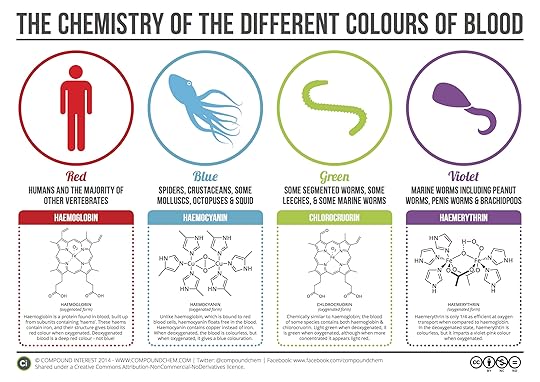Cyanoglobin
 A week ago, I reminded you that as we hit the home stretch for Tales of the Vuduri, I won't have time to truly flesh out all the Big Ideas I had for the novel The Milk Run. Instead, I am presenting some capsule summaries of the motivation behind a subset of those ideas. Today I wanted to talk about cyanoglobin versus hemoglobin. Why? My thinking was that not every planet would be iron-rich. I postulated that Hades, the Ice Planet, was copper-rich and iron-poor so that if life was going to evolve, it would have to make that part of its plans. Take a look at this chart showing the different types of blood (Chart courtesy of Andy Brunning and Compound Interest)
A week ago, I reminded you that as we hit the home stretch for Tales of the Vuduri, I won't have time to truly flesh out all the Big Ideas I had for the novel The Milk Run. Instead, I am presenting some capsule summaries of the motivation behind a subset of those ideas. Today I wanted to talk about cyanoglobin versus hemoglobin. Why? My thinking was that not every planet would be iron-rich. I postulated that Hades, the Ice Planet, was copper-rich and iron-poor so that if life was going to evolve, it would have to make that part of its plans. Take a look at this chart showing the different types of blood (Chart courtesy of Andy Brunning and Compound Interest)
You can click on the image to get a zoomed-in version. Note the second block, entitled haemocyanin (the British spelling) which is the proper scientific term for cyanoglobin. This is the principle oxygen-carrying molecule in spiders, crustaceans, shrimp! and horseshoe crabs. According to the author, unlike hemoglobin, hemocyanin does not bind to blood cells but rather circulates freely in the blood. And just like hemoglobin, it is a different color, nearly clear, when it is devoid of oxygen and bright blue when fully oxygenated.
Another little tidbit that I found out is that while hemocyanin is only a quarter as efficient in transporting oxygen as hemoglobin, it performs better in cold environments with low oxygen pressure. Like under the sea or, you guessed, the ice planet Hades. We have a winner! According to Sean McGrath, "It is not that hemocyanin gets better at carrying oxygen at low temperatures; it is just that hemoglobin gets worse at low temperatures."
Since shrimp becomes an important theme later in the book and I worked with horseshoe crabs in graduate school, I thought I'd give them and their blue blood its due. You might be interested to know that the blood of horseshoe crabs is harvested and used in the treatment of bladder and prostate cancer. The hemocyanin contains a specific antigen that causes the human immune system to start making an antibody that also destroys tumor cells. Pretty neat, huh?
Published on December 25, 2017 08:04
•
Tags:
action, adventure, ftl, science-fiction, space-travel, vuduri
No comments have been added yet.
Tales of the Vuduri
Tidbits and insights into the 35th century world of the Vuduri.
- Michael Brachman's profile
- 21 followers



